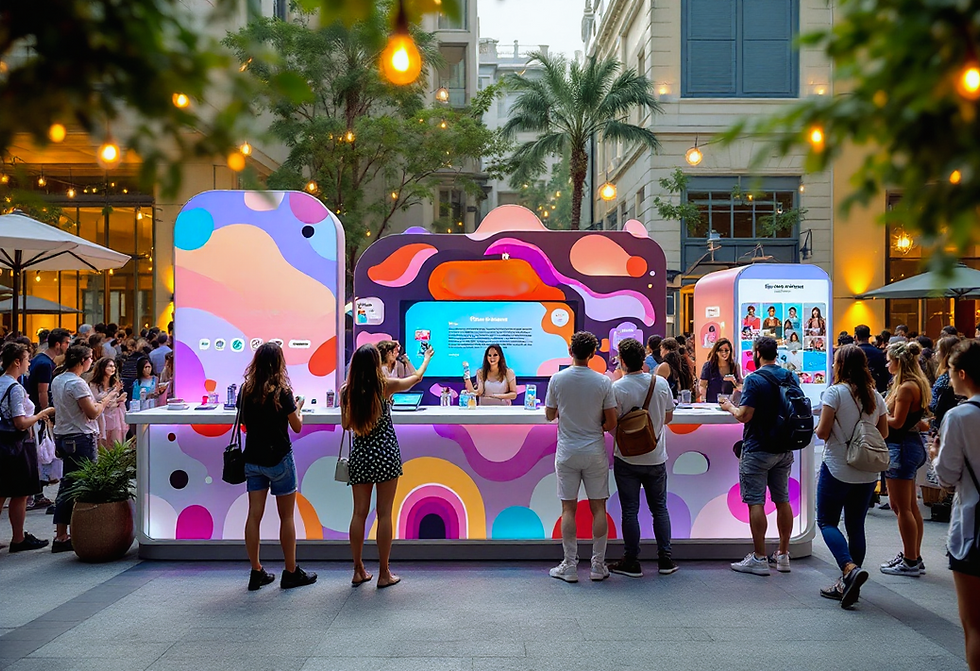Behind the Buzzwords: What ROI Really Means in Events
- Melissa Campbell

- Aug 17
- 6 min read
Updated: Dec 9
Welcome to Part 4 of our "Behind the Buzzwords" series. In this article we're exploring the term "ROI" and what it means in the marketing & events world.

"What's the ROI going to be?"
It's the question that ends more event planning conversations than it starts. Marketing teams want to justify budgets, executives demand measurable returns and event professionals scramble to quantify experiences that often feel intangible.
Here's the challenge: while everyone talks about event ROI, very few actually know how to define or measure in meaningful ways. The result is events that look impressive but struggle to prove their business value, and marketing budgets that get questioned when results can't be demonstrated clearly.
Let's explore what ROI actually means for events and how to build experiences that deliver measurable business impact.
Redefining Event ROI: Beyond Immediate Sales
Sin the simplest terms, Return on Investment or ROI is the value you get from the investment you make. But in events, "value" extends far beyond immediate revenue.
Event ROI is not just about tracking financials and sales. It might manifest as:
Direct Revenue Impact:
Product sales generated during or immediately after the event
New customer acquisitions with trackable lifetime value
Upsells or cross-sells to existing customers
Partnership deals initiated through event connections
Brand and Market Value:
Increased brand awareness and market share
Enhanced brand perception and positioning
Media coverage and earned publicity value
Social media reach and engagement expansion
Relationship and Community Building:
High-quality leads with strong conversion potential
Customer loyalty and retention improvements
Employee engagement and retention benefits
Industry relationships and partnership opportunities
Long-term Strategic Value:
Market research and customer insights gathered
Competitive intelligence and positioning advantages
Innovation ideas and product development insights
Thought leadership establishment in your category
The key insight: event ROI should align with your broader business strategy, and not just the immediate sales targets.
The Event ROI Measurement Problem
Many organizations struggle with event ROI because they approach measurement incorrectly:
Common Measurement Mistakes:
Focusing solely on attendance numbers: High attendance doesn't guarantee business value if attendees aren't your target audience or don't take desired actions.
Measuring only immediate outcomes: Many event benefits compound over time, but organizations only track 24-48 hour results.
Using vanity metrics: Social media mentions, photo booth usage, and app downloads might look impressive but don't necessarily drive business results.
Failing to establish baselines: Without pre-event benchmarks, it's impossible to prove that your event caused specific outcomes.
Ignoring qualitative impact: Some of the most valuable event outcomes, like shifting brand perception or strengthened relationships are difficult to quantify but crucial to track.
If you don't know what success looks like, then how can you prove it?
The Just Honest Strategic Framework for Event ROI
To create events that deliver measurable returns, we use a five-stage ROI framework:
Stage 1: Define Success Metrics
Before any creative development begins, establish clear, measurable objectives:
Primary objectives should directly tie to business goals (revenue, leads, brand awareness)
Secondary objectives might include relationship building, market research, or competitive positioning
Success thresholds define what constitutes good, great, and exceptional performance
Stage 2: Design for Measurement
Build tracking capabilities into your event design from the start:
Digital integration allows for precise behavior tracking and follow-up campaigns
Lead capture systems should feel natural and provide value to participants
Feedback mechanisms gather both quantitative data and qualitative insights
Content strategy creates repurposable assets that extend event value
Stage 3: Execute with Intention
Every event element should serve your ROI objectives:
Audience targeting ensures you're investing in reaching the right people
Experience design guides attendees toward desired actions and outcomes
Staff training equips your team to recognize and capitalize on ROI opportunities
Real-time optimization allows for adjustments based on live performance data
Stage 4: Track Comprehensive Impact
Monitor both immediate and long-term results:
Immediate metrics: Lead generation, sales, social engagement, media coverage
Short-term impact: Website traffic, newsletter signups, demo requests, trial activations
Long-term value: Customer lifetime value, brand perception shifts, market share changes
Stage 5: Analyze and Optimize
Use event data to improve future performance:
ROI calculation should include both quantitative returns and qualitative value
Performance analysis identifies which event elements drove the strongest results
Optimization planning applies insights to future event strategies
Events and experiences shouldn't just look good, they should provide measurable results and our framework ensures this.
Event Design Strategies That Maximize ROI
Strategic Lead Generation: Instead of generic contact collection, create value-exchange moments where attendees willingly share information in return for meaningful experiences or exclusive content.
Behavior-Driven Interactions: Design activities that naturally guide attendees toward your desired outcomes, whether that's product trial, education, or community building.
Content Multiplication: Create event experiences that generate repurposable content, extending your investment value through ongoing marketing campaigns.
Relationship Catalysts: Build in structured networking and connection opportunities that continue generating value long after your event ends.
Data-Rich Experiences: Incorporate technologies and activities that provide valuable customer insights while enhancing the attendee experience.
Industry-Specific ROI Considerations
B2B Events: Focus on lead quality over quantity, relationship building, and long sales cycle nurturing. ROI often materializes 6-12 months post-event.
Consumer Brand Events: Emphasize brand awareness, social sharing, and immediate conversion opportunities. ROI typically shows in weeks or months.
Internal Corporate Events: Measure employee engagement, retention, productivity, and culture metrics. ROI appears in reduced turnover and increased performance.
Product Launch Events: Track pre-orders, media coverage, social buzz, and market penetration. ROI should be evident in launch success metrics.
Common ROI Obstacles (And Solutions)
Challenge: Long sales cycles make immediate ROI unclear Solution: Track leading indicators like engagement depth, demo requests, and pipeline progression rather than just closed deals.
Challenge: Attribution difficulty when multiple touchpoints influence customers Solution: Use UTM codes, unique landing pages and customer journey mapping to better track event influence.
Challenge: Qualitative benefits resist quantification Solution: Develop proxy metrics (brand sentiment scores, share of voice measurements) and assign estimated values based on industry benchmarks.
Challenge: Limited budget for comprehensive tracking Solution: Prioritize tracking your primary objective thoroughly rather than measuring everything superficially.
Building ROI into Your Event Strategy
Pre-Event Planning:
Establish clear business objectives tied to company goals
Define success metrics and measurement methodologies
Build tracking capabilities into event design
Create post-event follow-up strategies
During the Event:
Monitor real-time engagement and adjust tactics
Capture high-quality leads and behavioral data
Generate content for ongoing marketing use
Build relationships that extend beyond the event
Post-Event Analysis:
Calculate comprehensive ROI including all value streams
Analyze which elements drove strongest returns
Apply insights to future event planning
Report results in business terms stakeholders understand
The Future of Event ROI
As marketing budgets face increased scrutiny and alternatives to live events multiply, proving ROI becomes more critical. The events that survive and thrive will be those that demonstrate clear business value and continuous optimization.
This means moving beyond "event as expense" thinking toward "event as investment" strategies—where every element is designed to generate measurable returns and every outcome is tracked to inform future decisions.
The organizations that master event ROI measurement will not only justify their event investments but also optimize them for increasingly better results.
At Just Honest Events, we specialize in designing ROI-focused experiences that prove their value from day one. Let's discuss how to transform your event investment into demonstrable business returns. Ready to create events that deliver measurable business impact?
Follow us for behind-the-scenes, event tips and industry trends:
Disclaimer
The content published on this blog is for informational and inspirational purposes only. While we strive to provide up-to-date insights, expert opinions, and industry trends, the information shared should not be considered as professional advice tailored to any specific event or business need.
All views expressed in our blog posts are our own and are intended to inspire creativity, spark innovation, and provide valuable insights into the world of event marketing and management. However, event strategies, technologies, and trends evolve rapidly, and we recommend consulting with a professional before making any major event-related decisions. Additionally, any third-party tools, platforms, or services mentioned in our blog posts are referenced purely for educational purposes. We do not endorse or receive compensation for mentioning them unless explicitly stated.
By using this blog, you acknowledge that we are not responsible for any direct, indirect, or consequential decisions made based on the information provided. We encourage readers to use their discretion, conduct their own research, and reach out for personalized guidance if needed. For expert consultation on event marketing strategies, sustainable event planning, or creating unforgettable brand experiences, feel free to contact us directly.
© Just Honest Events and www.justhonestevents.com 2025. Unauthorized use and/or duplication of this material without express and written permission from this site’s author and/or owner is strictly prohibited. Excerpts and links may be used, provided that full and clear credit is given to Just Honest Events and www.justhonestevents.com with appropriate and specific direction to the original content.



